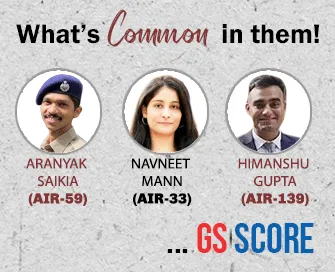

25th August 2023 (8 Topics)
Editorials
Context
Africa's rising role in global platforms like BRICS and G-20 reveals its challenges - misgovernance, terrorism, tribal conflicts, and more. India's strong ties with Africa can provide innovative solutions through these forums.
Challenges and Disruptors
- Existential Challenges: Africa grapples with misgovernance, unplanned development, tribal dominance, and corruption.
- New Disruptors: Emerging threats include Islamic terrorism, tribal conflicts, climate change, food inflation, urbanization, and youth unemployment.
- Intervention Complexities: Military interventions by foreign powers worsen the situation, often perpetuating dictatorships to safeguard economic interests.
Return of Generals and Political Disorder
- Resurgence of Generals: Over the past decade, military leaders have come back to power in countries like Egypt, Burkina Faso, Mali, and Niger.
- Divided Armed Forces: Libya and Sudan experience internal splits among their armed forces, leading to power struggles.
- Complexity of Generals' Return: The resurgence is driven by intricate national factors, challenging efforts to curb this trend.


Editorials
Context:
The newly introduced rules by the Union Health Ministry that require anti-tobacco warnings for smoking scenes on OTT platforms, intended to raise awareness about tobacco's ill effects, are being critiqued for their force-fitted nature and lack of industry consultation.
Distinction and Concerns
- Application of Theatre/TV Rules: New rules mandate anti-tobacco warnings for OTT platforms similar to theatres and TV.
- Lack of Contextualization: The rules overlook distinctions between OTT and traditional media, raising concerns about the viewing experience.
- Industry Pushback: The absence of industry consultation has led to criticism and resistance against the rules due to their impractical implementation.
OTT's Unique Attributes
- OTT Growth: The OTT market's exponential growth in India is attributed to personalized content delivery and on-demand viewing.
- Self-Regulation Framework: Unlike theatres/TV, OTT operates under self-regulation through the Digital Media Ethics Code.
- Viewing Experience Impact: Force-fitting warnings disrupt binge-watching and short-form content, and efficacy concerns are raised regarding repeated exposure.
Complex Challenges and Way Forward
- Compliance Challenges: Imposing warnings across extensive OTT libraries within a short timeframe presents resource-intensive difficulties.
- Light-Touch Approach: Evolving technology-driven models like OTT should be governed with innovation and growth in mind.
- Consultation and Self-Regulation: The editorial suggests addressing tobacco depiction concerns through industry consultation and existing self-regulatory mechanisms.


Editorials
Context
Despite being the fastest-growing large economy, India faces the issue of high employment. The situation highlights the need of good infrastructure, both physical and human, to create more jobs.
Lop-sided Development and Unemployment
- India's Growth-Unemployment Paradox: India's rapid economic growth alongside high youth unemployment is attributed to skewed development policies.
- Demographic Advantage: With a significant young population, India's demographic structure offers potential, but lack of jobs constrains its benefits.
- Importance of Balanced Growth: The necessity of creating employment opportunities aligned with economic growth is emphasized.
Human Infrastructure Deficit and Education
- Infrastructure Imbalance: While physical infrastructure has progressed, the deficit in human infrastructure, particularly education and skills, hampers job growth.
- Education's Impact on Job Creation: Investing in education is key, as the returns on education investment are high, and educated individuals contribute to job creation.
- Challenges and Quality Concerns: Poor quality, faculty shortages, outdated curricula, and the need for creative thinking hinder effective education delivery.
Governance, Tertiary Education, and De-urbanization
- Governance Enhancement: The complexity of the education system necessitates improved governance, monitoring, accountability, and performance assessment.
- Role of Tertiary Education: Scaling up tertiary education can create a professional workforce capable of driving new enterprises and job creation.
- Urbanization and Job Creation: India's urbanization and industrialization paths have diverged, leading to pre-mature de-industrialization, underscoring the importance of balanced spatial development.


Editorials
Context
The recent discontent among onion growers regarding the 40% export duty imposed by the Indian government highlights the challenges faced by farmers of onions, potatoes, and tomatoes who lack Minimum Support Price (MSP) benefits, making them reliant on market forces.
Price Volatility and Government Response
- Market Vulnerability: Farmers of onions, potatoes, and tomatoes experience price volatility due to market dynamics.
- Lack of MSP Support: Unlike other crops, these farmers lack the safety net of MSP-based procurement by government agencies.
- Differential Attention: The government's intervention varies based on price fluctuations, leading to criticism and farmer frustration.
Farming Practices and Consequences
- Crop Storage Strategies: Onion farmers adopt staggered sales through storage structures to counter market fluctuations.
- Impact of Unseasonal Rains: Unusual excess rains damaged a portion of harvested onions, affecting storage quality.
- Price Fluctuations: The combination of damaged stored onions and distress sales due to rapid quality deterioration caused price fluctuations.
Short-Sighted Policy and Repercussions
- Government's Reactive Approach: The government's reactive approach to rising prices after neglecting low prices is criticized.
- Erosion of Reforms: Recent actions, such as export bans and stock limits, undermine the spirit of farm reform laws introduced earlier.
- Global Supplier Reputation: Export restrictions jeopardize India's credibility as a dependable global supplier and present a challenge to restoring it.



